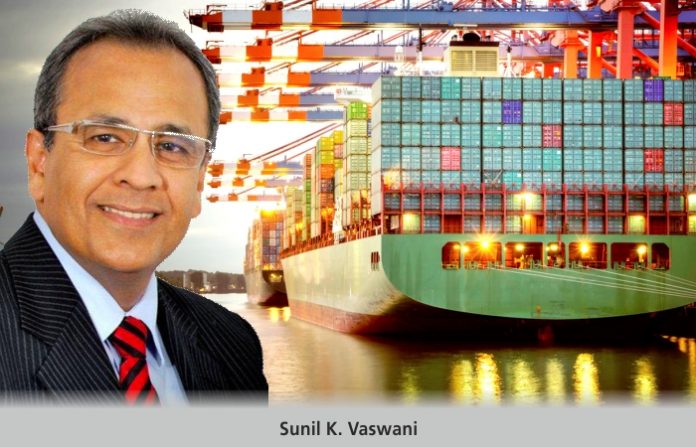The cost of logistics in India remains high at 14 per cent of the GDP, as compared to eight to nine per cent in the case of the developed economies of the world. Sunil K. Vaswani, Executive Director, Container Shipping Lines Association (CSLA) India talks about major factors which have led to an increase in the cost of logistics in the country.
While on the one hand, India aspires to be a US$ 5 trillion economy by 2024-25, on the other, its cost of logistics remains high at 14 per cent of the GDP, as compared to eight to nine per cent in the case of the developed economies of the world. The reasons for these are varied, some of which are commonly known while the others, although equally important if not more, are not generally talked about. Here are some of the spots where the shoe really pinches.
High port charges
India’s port charges remain amongst the highest in the world. Total port call cost of a vessel of the same size calling at Indian ports viz-a-viz the foreign ones – the vessel related charges at Indian ports are far higher than those at neighbouring foreign ports. These work out to USD 108,437 at the New Terminals at Nhava Sheva i.e. BMCT / NSIGT & USD 64,592 at the Old Terminals at Nhava Sheva i.e. JNPCT / GTI / NSICT, as compared to USD 12,043 at P. Klang, USD 16,158 at Jebel Ali, USD 17,235 at Singapore & USD 19,308 at Colombo. These charges at Indian ports will increase even further if the tariffs are revised.
Total container related cost – These costs too are much higher at the New Nhava Sheva Terminals (BMCT & NSIGT), Mundra & Pipavav, as compared to those at foreign ports. Again, these costs at Indian ports could increase further, including the ones at the Nhava Sheva old terminals, should the Indian ports go ahead with a revision in their tariffs.
Unit cost per move – Even at the existing rates, the unit cost per move, works out much higher (approximately double or even almost triple the cost) for a vessel calling at Indian ports, as compared to it calling at foreign ports.
Under the circumstances, it is not only economically challenging for the shipping lines to call at Indian ports but also difficult for Indian exports to be globally competitive and Indian imports to be price-sensitive in the domestic market. A reduction in the Indian port charges would therefore help in bringing down the cost of logistics.
Dual charge
Some of the ports like JNPT for instance, charge a dual charge to the lines calling there.
This is with reference to the MBPT dues paid by all the shipping lines at Nhava Sheva. Presently, all the container vessels call at either of the five container terminals at JNPT. During the year 2019, a total of 1,586 container vessels called at the five terminals at JNPT.
Since the inception of JN Port during the year 1989, all the shipping lines have been paying both the MBPT as well as the JNPT dues. Earlier the MBPT dues were not so unaffordable due to the smaller size of vessels and the lesser number of calls at JNPT. Now with the sizes of vessels having increased from 2700 TEUs (26,000 GRT) to the range of 9,000 TEUs (109,712 GRT) / 14,000 TEUs (128,000 GRT), the MBPT dues are indeed getting to be unaffordable for the shipping lines.
In order to allow larger parcel size vessels to call at Nhava Sheva, JNPT carried out capital dredging, thereby enabling vessels with 15 Mtr arrival draft and 14,000 TEU capacity (over 100,000 GRT) to call at the port. While the cost of the capital dredging was borne by JNPT, with no contribution from MBPT, it still recovers a significant chunk of the port dues through JNPT, from vessels calling therein. The vessels entering into JNPT, are managed by the JNPT Marine Department and no services whatsoever are provided by MBPT.
Due to the prevailing market scenario in view of the COVID pandemic, most of the vessels are in any case under-utilised and these additional costs further impact the bottom lines of the vessels calling at JNPT. The above port costs therefore prove detrimental towards the government’s initiative of reducing the transaction cost and further improving India’s ranking in the Ease of Doing Business.
IMO requirements
IMO requirements of usage of fuel with no more than 0.5 per cent sulphur, from January 1, 2020, put additional pressure on the shipping lines. Many lines had to either install scrubbers or go in for new vessels.
High inland haulage charges
With rail operators padding on margins, which can go up to about 20 per cent, over and above the rail freight, the increased cost impacts India’s exports & imports adversely. The monopolistic nature of CONCOR’s operations adversely impact the logistics’ cost of the country – a point that cannot be ignored.
Cabotage relaxation
Cabotage relaxation was recently allowed because:
- It was at the behest of importers who could avail of cheaper and quality coastal shipping from the west to the east coast of India and vice versa.
- It provided an incentive for India to be a transshipment hub so as to retain cargo, at least partially, that was otherwise lost to neighbouring foreign ports like Dubai, Singapore & Colombo. Besides, it would help retain / provide additional employment.
- If the relaxation was to be lifted, India could end up losing about one million TEUs of transshipment containers a year that it has gained due to this relaxation.
- It is also pertinent that coastal shipping may attract ships that are well past their good shelf-life or due to reduced SOLAS, MARPOL or other relaxations could constitute a possible environmental threat. Also considering there may not be a P&I protection insurance or adequate insurance in case of a mishap, there could be an issue of handling such a threat. All this could further add to the cost of logistics of the country.
Fragmented market
A fragmented market spread across the length & breadth of the country calls for infrastructure development, efficient and cost-effective inland transportation, first & last-mile deliveries, modern warehousing, etc.
Cargo mix
The country’s import & export commodities have different transportation requirements. While India’s imports are mostly 40 ft driven, its exports need, by & large, 20 ft boxes. This creates an equipment imbalance which poses both operational as well as financial challenges for the shipping lines.
Intermediaries
Thousands of so-called logistics providers have mushroomed across the country. However, barring a few, the remaining essentially tend to pad on margins without offering any real value to the end customer, thereby adding significantly to cost of logistics of the country.
Shortage of skilled manpower
With limited availability of recognised courses & preference of the younger generation for other professions, shortage of trained manpower in logistics continues. This gap can be bridged, to an extent, through online programmes, simulation models, on-the-job training, etc., to help improve the service levels & bring down the costs.
Digitalisation
The way to go, particularly in today’s COVID environment is, elimination or at least minimisation of manual intervention would help improve efficiencies and thereby assist towards reduction in the cost of logistics.
India has, by & large, been doing economically better than many other countries in the world. However, understanding where the real problems lie and addressing those systematically, would help improve efficiencies and reduce the cost of logistics.
JNPT opts for capital dredging
In order to allow larger parcel size vessels to call at Nhava Sheva, JNPT carried out capital dredging, enabling vessels with 15 Mtr arrival draft and 14,000 TEU capacity to call at the port.
(The views expressed are solely of the author. The publication may or may not subscribe to the same.)














